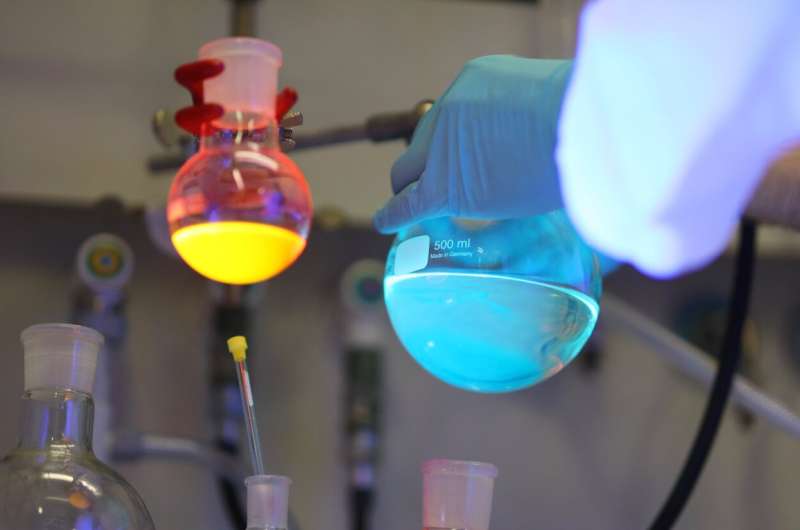This article has been reviewed according to Science X's editorial process and policies. Editors have highlighted the following attributes while ensuring the content's credibility:
fact-checked
trusted source
proofread
Applying green chemistry principles to iron catalysis

At the Leibniz Institute for Catalysis in Rostock, Dr. Johannes Fessler has developed new methods for the synthesis of drug precursors using catalysts made of iron, manganese and cobalt. Each of these three chemical elements has the potential to replace a number of noble metals that are commonly used in organic chemistry to catalyze fine chemicals.
Platinum and palladium, for example, are expensive due to their rare occurrence, their extraction is costly and they release large quantities of the greenhouse gas CO2. One of the goals of "green" chemistry is therefore to dispense with such noble metals in organometallic catalysis in the future.
Johannes Fessler gained his findings as part of his dissertation, which he defended in January. He has reported on it in Chemical Science, together with his doctoral supervisor Prof Dr. Matthias Beller and his research group leader Dr. Kathrin Junge. For example, you can read how a complex active ingredient candidate based on pyrrole, a common drug precursor, is created from "simple starting materials" with the help of an acid-tolerant homogeneous iron catalyst and at room temperature.
"Homogeneous" catalysis means that the starting materials, catalyst, solvent and ultimately the product and by-product are dissolved in a single reaction vessel. They must therefore be separated after each reaction step, purified and prepared for the next step, as Dr. Fessler explains.
"If you manage to save one of these steps in the chemical process, you greatly reduce the amount of time and material required and minimize waste." This is exactly what he achieved with the reaction to pyrrole, using a reaction cascade.
Replacing noble metals as catalysts with iron, and the like, has become an attractive research topic internationally. LIKAT has built up strong expertise in this field over the past few years. Johannes Fessler estimates that a quarter of his young colleagues at the institute are working on non-noble metal catalysis in their doctoral theses.
On the one hand, this work helps to conserve resources. Dr. Fessler says, "The task of climate-neutral, sustainable management is facing the chemical industry as well as all other sectors." Iron is abundant, making up 5% of the Earth's crust. And after iron and titanium, manganese is the most common transition metal (this name comes from its place in the periodic table) on Earth.
On the other hand, there is a reason why base metals have so far only played a marginal role in organic chemistry. "They are often less stable in catalytic processes than catalysts made of noble metals," says Dr. Fessler. "In addition, they usually work at high temperatures and pressures in the area I am researching."
However, such harsh conditions would destroy the complex molecules in drug production. The chemical structures that ensure the specific effect of a drug, the so-called functional groups in the molecule, are particularly at risk.
High chemical precision in implementation
In this respect, it is a great success to be able to show how catalysts made of iron, manganese and cobalt can sometimes manage with significantly milder reaction conditions compared to previous practice.
In the case of pyrrole, these are temperatures between 20 and 30 degrees Celsius. Johannes Fessler's experiments revealed another advantage of his approach: His non-noble metal catalysts very precisely converted only those molecules that the chemists needed in the actual synthesis. "We call this approach highly selective. It produces hardly any by-products or waste."
Johannes Fessler tested the reliable functioning of his reaction on various active ingredients and drug precursors. "We wanted to make sure that the iron catalyst also activates the right place in the molecule for these substances and spares the sensitive functional groups." In this way, the chemist tested his method on widely used cholesterol-lowering drugs and blood pressure medications, among others.
Chemistry excursion: Cascade reaction
Finally, the cascade reaction mentioned at the beginning requires a nitrogen-containing substance called nitroarene as the starting substance, which is hydrogenated in the first step using formic acid and a commercially available iron catalyst and then immediately undergoes a subsequent reaction to form pyrrole. Pyrrole is a common fine chemical in the pharmaceutical sector. It is one of the heterocycles, ring-shaped carbon compounds in which one carbon atom (C) is replaced by another element, e.g. nitrogen (N).
The cascade reaction comprises two steps. In the first, the nitroarene is hydrogenated to form an amine, also known as aniline, a benzene ring with an amino group (NH2), which immediately enters into a subsequent reaction. In this subsequent reaction, the second step, the amino group is reacted with a dicarbonyl compound with elimination of water. It thus condenses to form pyrrole.
The cascade succeeds due to the acidic environment, for which formic acid is responsible in a dual function, as a reducing agent and as an acid. However, this requires a catalyst that works well under acidic conditions. This is precisely the case with the iron-based catalyst used by Johannes Fessler.
More information: Johannes Fessler et al, Applying green chemistry principles to iron catalysis: mild and selective domino synthesis of pyrroles from nitroarenes, Chemical Science (2023). DOI: 10.1039/D3SC02879H
Provided by Leibniz Institute for Catalysis





















